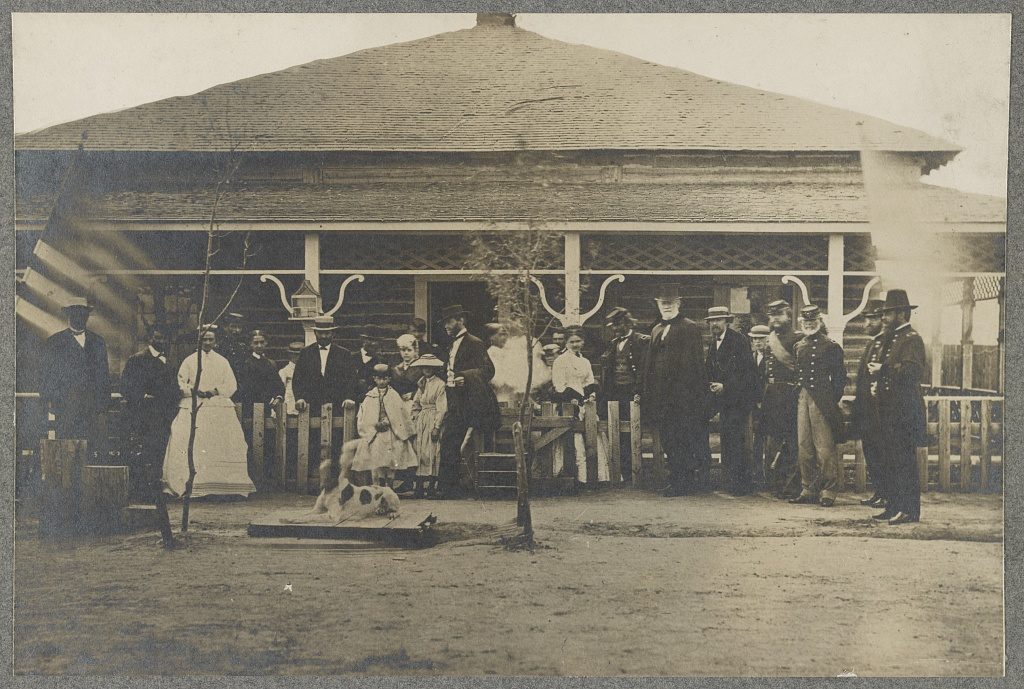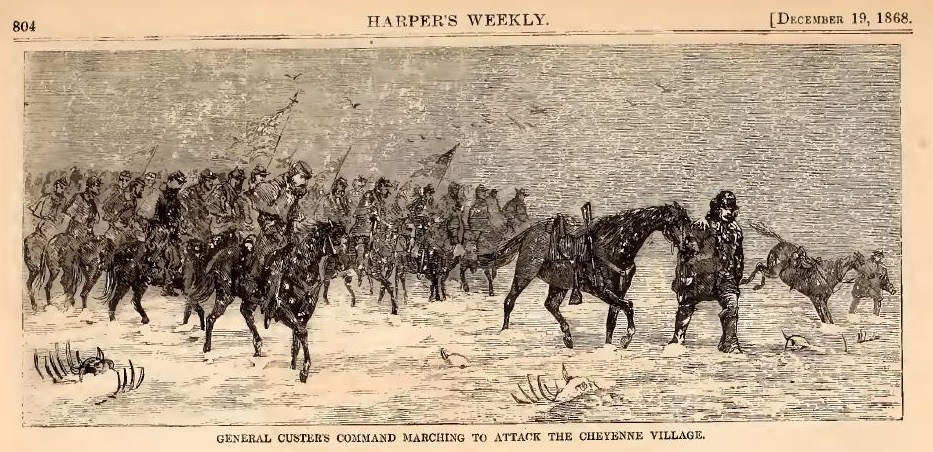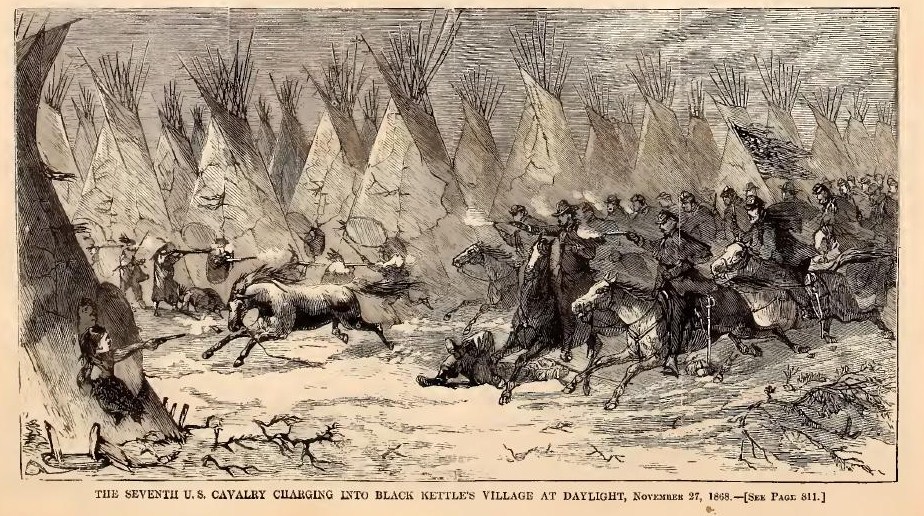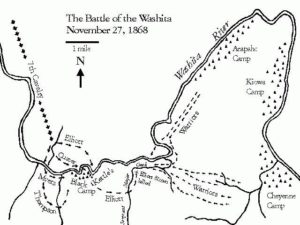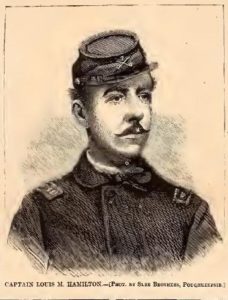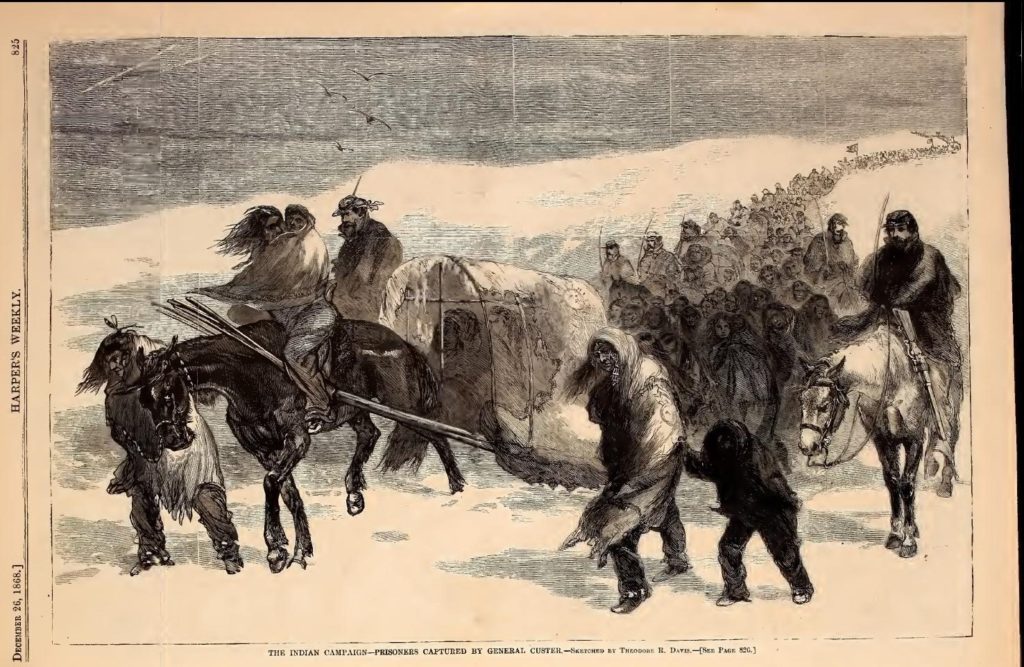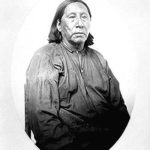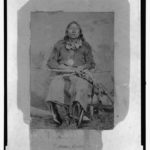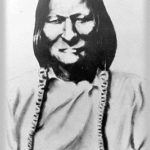From the December 19, 1868 issue of Harper’s Weekly:
THE INDIAN WAR.
GENERAL SHERIDAN has conceived a plan of Indian warfare which will yield substantial results. General SHERMAN’S report to the War Department from St. Louis, on the 2d instant, incloses a report from General SHERIDAN of the first stage of his campaign. As SHERMAN says, “it gives General SHERIDAN a good initiation.” It seems that at the start SHERIDAN met with old acquaintances. “The bands of BLACK KETTLE, LITTLE RAVEN, and SANTANTA are well known to us, says SHERMAN, “and are the same that have been along the Smoky Hill for the past five years, and ……embrace the very same men who first began this war on the Saline and Solomon rivers.
General SHERIDAN reports from Canadian River, junction of Beaver Creek, Indian Territory, November 29, 1868:
“I have the honor to report, for the information of the Lieutenant-General, the following operations of General CUSTER’S command: On the 23d of November I ordered him to proceed with eleven companies of the Seventh Cavalry in a southerly direction toward the Antelope Hills in search of hostile Indians. On the 26th he struck the trail of a war party of BLACK KETTLE’S band returning from the north, near where the eastern line of the pan-handle of Texas crossed the main Canadian. He at once corralled his wagons and followed in pursuit over the head waters of the Washita, thence down that stream; and on the morning of the 27th surprised the camp of BLACK KETTLE, and after a desperate fight, in which BLACK KETTLE was assisted by the Arrapahoes [sic], under LITTLE RAVEN, and the Kiowas, under SANTANTA, we captured the entire camp, killing the chief, BLACK KETTLE, and 102 warriors, whose bodies were left on the field, all their stock, ammunition, arms, lodges, robes, and fifty-three women and their children. Our loss was Major ELLIOTT, Captain HAMILTON, and nineteen enlisted men killed. Brevet Lieutenant-Colonel BARNETZ, Brevet Lieutenant-Colonel J.W. CUSTER, Second Lieutenant Z. MARSH, and eleven enlisted men wounded. LITTLE RAVEN’S band of Arrapahoes and SANTANTA’S band of Kiowas were encamped six miles below BLACK KETTLE’S camp. About 800 or 900 of the animals captured were shot, the balance being kept for military purposes. The highest credit is due to General CUSTER and his command. They started in a furious snow-storm, and traveled all the while in snow about twelve inches deep. BLACK KETTLE’S and LITTLE RAVEN’S families are among the prisoners. It was BLACK KETTLE’S band that committed the first depredations on the Saline and Solomon rivers, in Kansas.
“The Kansas regiment has just come in. They missed the trail and had to struggle in the snow-storm. The horses suffered much in flesh, and the men were living on buffalo meat and game for eight days. We will soon have them in good condition. If we can get one or two more good blows there will be no more Indian troubles in my department. We will be plached[?] in ability to obtain supplies, and anture[?] will present many difficulties in our winter operations, but we have stout hearts and will do our best. Two white children were recaptured. One white woman and a boy ten years old were brutally murdered by the Indian women when the attack commenced.”
Cheyenne village was captured on the morning of November 27, as stated in the above report. General CUSTER on this occasion won fresh laurels.We regret the loss of HAMILTON, BARNETZ, and ELLIOTT; but we rejoice that one of the most hostile of the Indian encampments has been destroyed. SHERIDAN’S plan, as we have previously stated, is the destruction of Indian lodges. This, fully accomplished, will make it impossible for the savages to begin their depredations in the spring. SHERIDAN’S harvest is one which could only be garnered in the winter season, and thus far he has proved himself an efficient reaper.
From the December 26, 1868 issue of Harper’s Weekly:
INDIAN PRISONERS TAKEN BY CUSTER.
Our engraving on page 825 illustrates a peculiar feature of SHERIDAN’S plan of Indian warfare. His object is to break up the nomadic habits and to destroy the irregular settlements of the hostile Indians. He finds them as at Black Kettle village out of their proper place; he pounces upon them, shows his power by a physical conquest, breaks up their villages and lodges; but after that comes the most important and most difficult portion of his work:he has to bag the whole parcel of vanquished savages and bear them off – the warriors, the aged, and the young – to their proper reservation. And there the Indian must stay, understanding that if again found wandering he must suffer the severest penalties of martial law.
The action of Congress in transferring the entire management of Indian affairs to the War Department will very materially facilitate General SHERIDAN’S operations. The Department of the Interior has made a sad bungle of this Indian matter; its immense patronage has introduced corruption and almost criminal negligence and thus Indian agencies as well as the Indians themselves have become demoralized.The new arrangement will make it possible to reduce the Indians to their proper position in relation to the Government; it will make coercion possible in so far as that may be necessary, and it will bring peace to our borders through the stern lessons of war – the only lessons which savages can appreciate.
Our illustration shows the method adopted in transferring Indian prisoners to their reservations. The old men and women and pappooses [sic] are tied to ponies, as represented in the cut, while the hardy young Indians perform the tedious journey through the snow on foot.
According to the Wikipedia article about the Battle of Washita River the actual number of casualties has always been controversial, and historians still debate whether Washita was a battle or a massacre. Also, a footnote mentions that Black Kettle was not considered a military commander by the Cheyenne: “Among the Plains Indians a chief was elected as a peace and civil officer and there was no such office as war chief.”
In discussing the Battle of Washita in his memoirs (at Project Gutenberg) General Sheridan had a different view of Black Kettle:
Custer had, in all, two officers and nineteen men killed, and two officers and eleven men wounded. The blow struck was a most effective one, and, fortunately, fell on one of the most villianous of the hostile bands that, without any provocation whatever, had perpetrated the massacres on the Saline and Solomon, committing atrocities too repulsive for recital, and whose hands were still red from their bloody work on the recent raid. Black Kettle, the chief, was an old man, and did not himself go with the raiders to the Saline and Solomon, and on this account his fate was regretted by some. But it was old age only that kept him back, for before the demons set out from Walnut Creek he had freely encouraged them by “making medicine,” and by other devilish incantations that are gone through with at war and scalp dances.
When the horrible work was over he undertook to shield himself by professions of friendship, but being put to the test by my offering to feed and care for all of his band who would come in to Fort Dodge and remain there peaceably, he defiantly refused. The consequence of this refusal was a merited punishment, only too long delayed.
According to an American history textbook, the Civil War played a role in this story. Despite agreements protecting Indian land, European-Americans continued to push west in the mid-nineteenth century. “… in 1862, after federal troops had been pulled out of the West for service against the Confederacy, most of the plains Indians rose up against the whites. For five years intermittent but bloody clashes kept the entire area in a state of alarm.”[1]
The same textbook discusses Philip Sheridan’s ambivalence. It quotes him as saying, “The only good Indians I ever saw were dead. ” But also, “We took away their country and their means of support, broke up their mode of living, their habits of life, introduced disease and decay among them, and it was for this and against this that they made war. Could anyone expect less?”[2]
